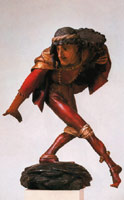
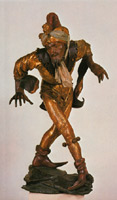
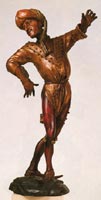
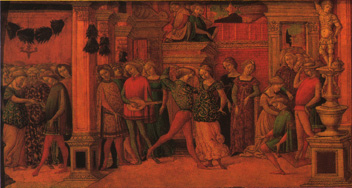
In addition to the very fact that courts of the nobility were in the habit of hiring a dancing teacher, a number of documents exist which illustrate the important role played by the dance. Ambassadors, for instance, describe in their letters dance events that take place at state banquets, weddings and other social occasions. The Dance, in particular the theatrical 'moresca's', was a welcome opportunity for the Renaissance prince to display his wealth and power. Neither effort nor cost were spared for the costumes and staging, in order to impress a political ally or rival. The dance itself played a subordinate role in this game: more important was the value of the clothing and the jewels worn by the dancers, as well as the expense of the festivities themselves. The dancing master Giovanni Ambrosio, in his autobiography, doesn't even bother to give us any details concerning his own moresca's :
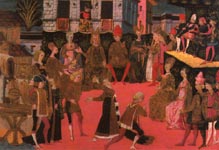
On occasion, dances from the tracts are mentioned by name in contemporary sources. When, for instance, pope Pius II stopped in Florence on the way from Rome to Mantua, that city organized (among other things) dancing parties which lasted for hours. In a poem that describes this particular event, dances are named which can be found in Domenico da Piacenza's tract: 'Leoncello' and 'Belriguardo'. Other sources mention still other dances out of the tracts: 'Gelosia' and 'Rostiboli'.
In 1490, 'Il Moro' organized the wedding of his nephew, Giangaleazzo Sforza, and Isabella of Aragon.
The dances for this sort of festivities can be divided into three groups:
Dances performed by the host (and/or hostess) and noble guests of the highest
rank. Only a few dancers were on the floor at any one time, easily visible
to the guests, while the public sometimes stood up as a gesture of respect.
Dances in which all who so desired joined in, this being dances such as the
saltarello's and the piva's. Only the bare footsteps here are known, but not
how they were in reality danced.



Moresca's theatrical dances in costumes and masks, usually with an allegorical, heroic or grotesque character. These were highly popular in the 15th, and provided entertainment for the guests during long pauses between courses at a banquet]. Chronicles as well the autobiography of Ambrosio give us something of a picture of these morescas, especially as far as the costly costumes, special effects and price-tags are concerned. The nobility was allowed to participate in such dances if they wore a costume and mask, but often it was the hired professional -jugglers, acrobats and actors- who performed them.
Ensemble Saltarello | back to index